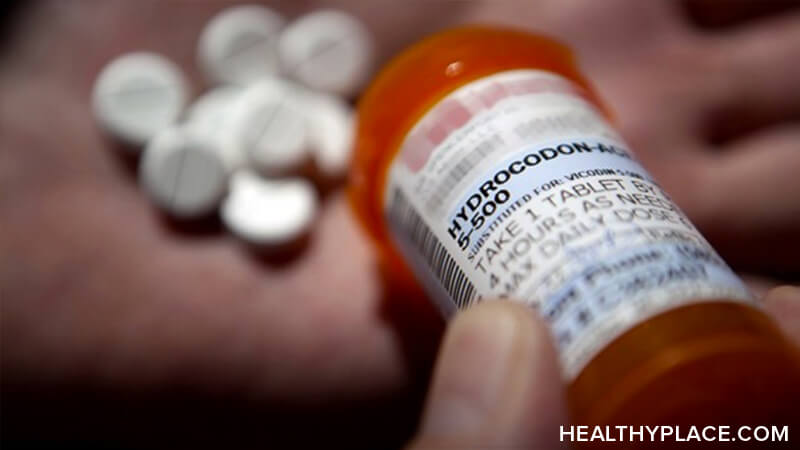Opioid Dependence vs. Addiction - Symptoms, Treatment

Opioids dependence will happen to anyone taking opioids, whether legal prescriptions for pain management or illegal street drugs. Dependence is a natural, and normal, result of any kind of opioid uses.
This has nothing to do with personal weaknesses and everything to do with how opioids work in the brain and body. Opioids mechanism of action guarantees dependence: When they attach to opioid receptors in the brain and body, they replace the body’s own natural opioids (such as endorphins). The brain stops making endorphins and other opioids and instead relies completely on the opioids we feed it. The brain and body become easily dependent upon opioid drugs.
This doesn’t mean that everyone taking opioid painkillers becomes addicted. There is a difference between opioids dependence and opioids addiction. Someone can develop a dependence on opioids without being addicted.
Opioid addiction symptoms include compulsive drug-seeking and use even when the person faces negative consequences. Someone experiencing addiction engages in other harmful, self-destructive behaviors as well yet continues to use. Addiction is a brain disease because the substance(s) used changes the brain, and it is these brain changes that lead to negative behaviors.
Dependency is much different from addiction. In opioids dependency, the body becomes used to the amount of opioids in the system. If you’re taking prescription opioid painkillers, for example, over time, the strength you started with will no longer be effective. You’ll need a greater amount of the same drug to achieve the same pain-relieving effect.
Dependence on opioids happens like this:
- Tolerance builds over time, which means that the body becomes used to the drug’s presence.
- The body and brain rely on the drug for normal functioning.
- If you try to stop or even reduce the amount of the drug, your body and brain react with opioids withdrawal symptoms.
This dependence on opioids can, and does, happen even when someone is not addicted. It also happens with any opioid drug, legal or illegal, and it can happen even under a doctor’s care. Further, opioids dependence actually has two forms: physical dependence and psychological dependence.
Types of Opioids Dependence: Physical and Psychological
Physical dependence on opioids relates to the physical structure of the brain and the body. The body itself, from the basic cellular level (the opioid receptors) all the way to the system as a whole, reacts and responds to the presence of opioids. Once it’s accustomed to the presence of opioids, it must continue to have them in order to function. Physical dependence is a condition of the body.
Psychological dependence, on the other hand, has to do with the brain’s reward system. Opioids bring pain relief. So taking opioids offers the reward of feeling better. That is physical, of course, but it’s also psychological. The person taking opioids becomes mentally and emotionally dependent on them because he needs the reward of reduced pain.
Physical and psychological dependence is a given part of opioid use. How, though, does someone know if she has become dependent on opioids? Certain symptoms indicate dependence.
Symptoms of Opioids Dependence
The biggest indicator that someone has become dependent on opioids, including prescription painkillers, is that she needs more to achieve the same level of pain control. A doctor might need to prescribe higher doses or add additional daily doses, but the level of pain relief remains the same.
Another sign of opioids dependence is the inability to reduce or stop taking the medication. Any attempt to reduce the amount of opioids in the system is met with opioids withdrawal symptoms.
Opioid dependence withdrawal symptoms aren’t dangerous, but they can be extremely uncomfortable. They include physical and mental symptoms such as
- Anxiety
- Irritability
- Cravings
- Confusion
- Rapid breathing
- Yawning
- Runny nose
- Salivation
- Goosebumps
- Chills
- Stuffy nose
- Muscle aches
- Nausea and/or vomiting
- Abdominal cramps
- Diarrhea
- Sweating
- Enlarged pupils
- Tremors
- Loss of appetite
Opioid Dependence Treatment
Dependence is uncomfortable, and it can keep people chained to opioid use. Happily, opioid dependence treatment is available.
Some opioid dependence treatment options include
- Outpatient treatment in special facilities/clinics
- Inpatient treatment/hospitalization
- Counseling
- Support groups
Sometimes medication is used to treat opioid dependence withdrawal symptoms and prevent relapse. Opioid antagonists can be used. They block the opiate receptors in the brain and body and include opioid drugs such as
- Methadone
- Buprenorphine
- Naloxone
- Naltrexone
Sometimes other medications are used to treat opioid dependence. Clonidine, for example, is a blood pressure medication that works to reduce dependence, and non-opioid pain medications can be used as well.
In addition to treating opioids dependence with medications, counseling and social support, including support groups, are trusted methods, too. Counseling helps people learn skills and strategies for dealing with dependence. Support groups provide connections to people experiencing something similar and can be an excellent resource for healing.
Opioids dependence is treatable. Because it can happen easily, it’s something that many people have experienced. Working with a medical or mental health professional and seeking support from others who have experienced dependence can be empowering and help you overcome opioids dependency.
APA Reference
Peterson, T.
(2021, December 16). Opioid Dependence vs. Addiction - Symptoms, Treatment, HealthyPlace. Retrieved
on 2025, November 28 from https://www.healthyplace.com/addictions/opioid-addiction/opioid-dependence-vs-addiction-symptoms-treatment



